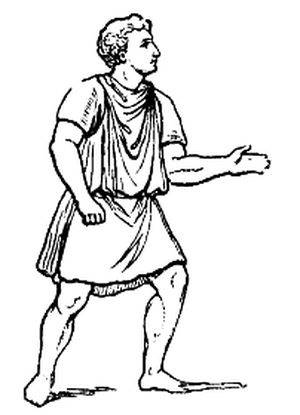Clothing in the Ancient World
Types of clothing used in the ancient world depended on the technologies that were invented in that time. We have evidence about what people wore then from depictions of people in the art of the time and from archeological findings of fabric fibers and leathers that are sometimes very well-preserved. The actual textile was probably felt. Nålebinding was also another early textile technique and it dates from 6500 BC.
Earliest woven textiles of the Near East may be fabrics dated to c. 6000 BC. They were used for wrapping the dead and are found at a Neolithic site at Çatalhöyük in Anatolia. Flax was cultivated from c. 8000 BC and breeding of sheep with a wooly fleece from 3000 BC.

In Ancient India, cotton was used as material for clothing from 5000 BC.
In Ancient Egypt most of the textile was made out of flax. Wool was known, but was used rarely (only for coats that were for instance forbidden in temples and sanctuaries) because it was considered impure as animal fibers were considered taboo. Complex clothing was reserved for higher classes while lower class wore only the loincloth or schenti. Bothe women and men wore same shoes - sandals braided with leather or, if they were bureaucrats and priests, braided with papyrus. They also wore tunics, robes, short-sleeved shirts, pleated skirts. Women also wore draped dresses made of white or unbleached fabric.
Cretan clothes were made from wool and flax from which loincloths were made. The women of Crete wore longer loincloths as underskirts with belt on which was fixed a large dagger. They also wore a long or short coat and a hat. Dresses were secured with brooches. Loincloths that men wore were in a shape of a short skirt or apron. Long clothing was in a shape of a coat made of wool and was worn for protection against bad weather.
Ancient Greek clothing consisted of lengths of linen or wool fabric which had rectangular shape. They were secured with clasps or pins at the shoulder and belt, sash or girdle at the waist. Women wore peplos which was a heavier woolen body-length garment with shoulder clasps. A simple tunic garment of lighter linen called chiton worn by both men and women. A strophion was an undergarment which women wore around the mid-portion of the body. Men wore a type of cloak from a seamless rectangle of woolen material and called chlamys.
One of the most famous items of clothing from Ancient Rome is toga - a one-piece woolen garment that draped loosely around the shoulders and down the body. There is evidence that toga was worn by all free Romans during the Roman monarchy and the Roman Republic, while slaves and children wore tunics. After the 2nd century BC, togaa was worn over tunic by men while women wore stola, a long pleated dress similar to the Greek chitons. Girls and boys under the age of puberty wore a toga praetexta. It was special type of toga with a purple band on the lower edge.
